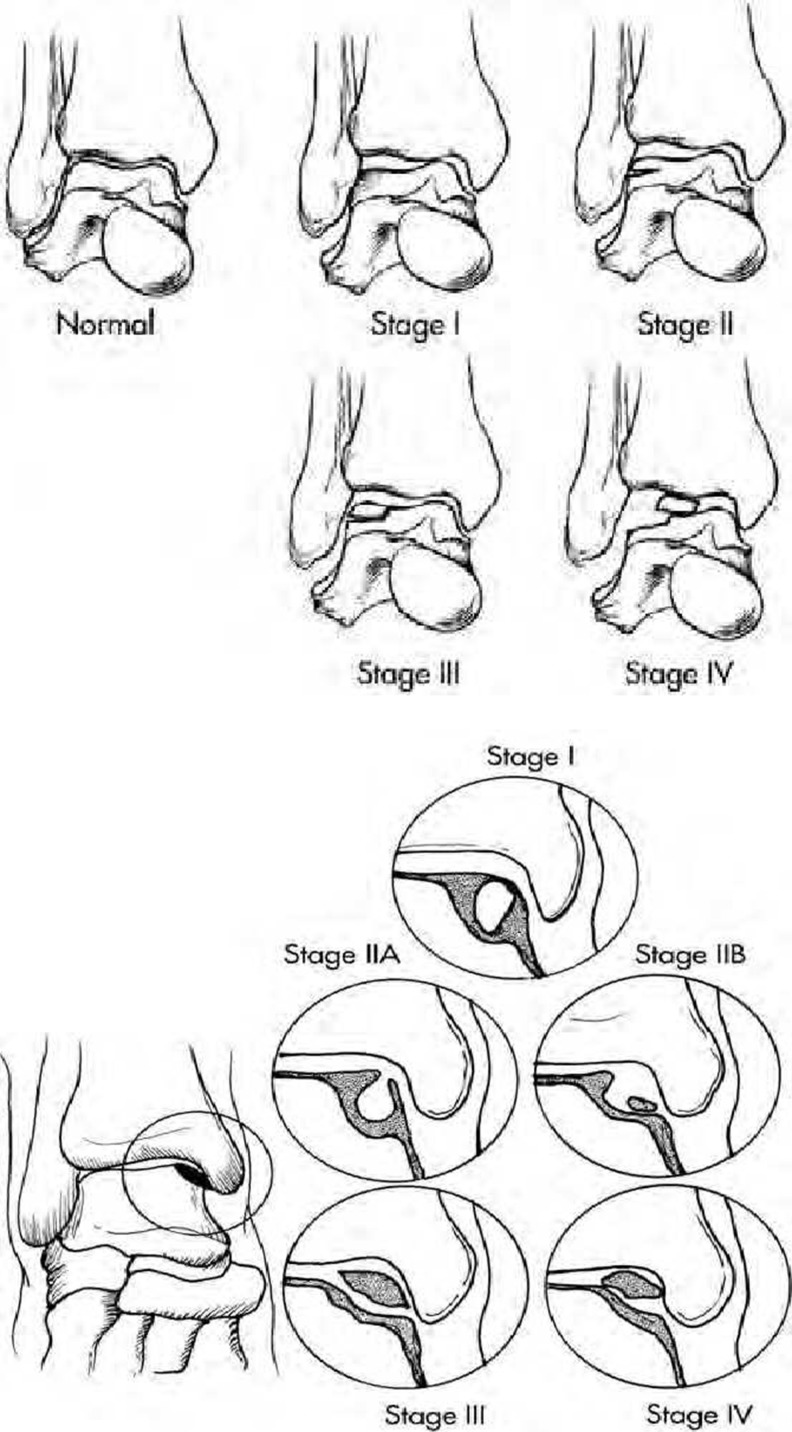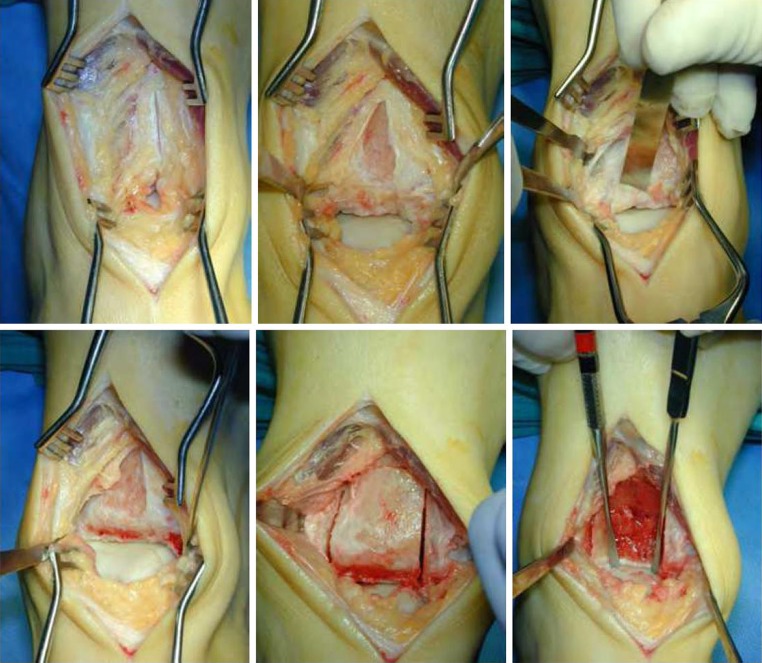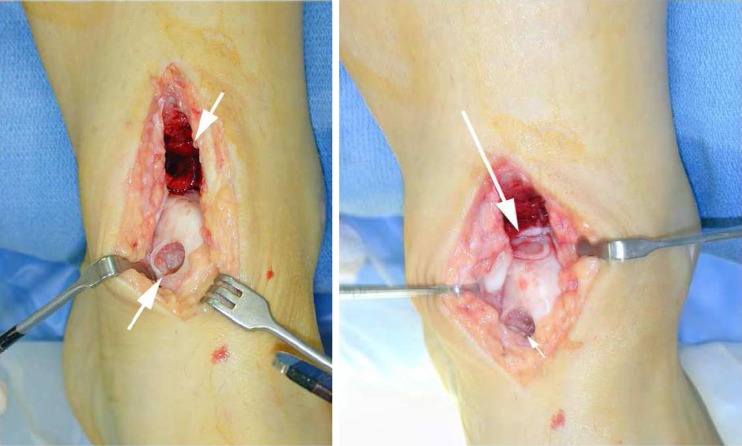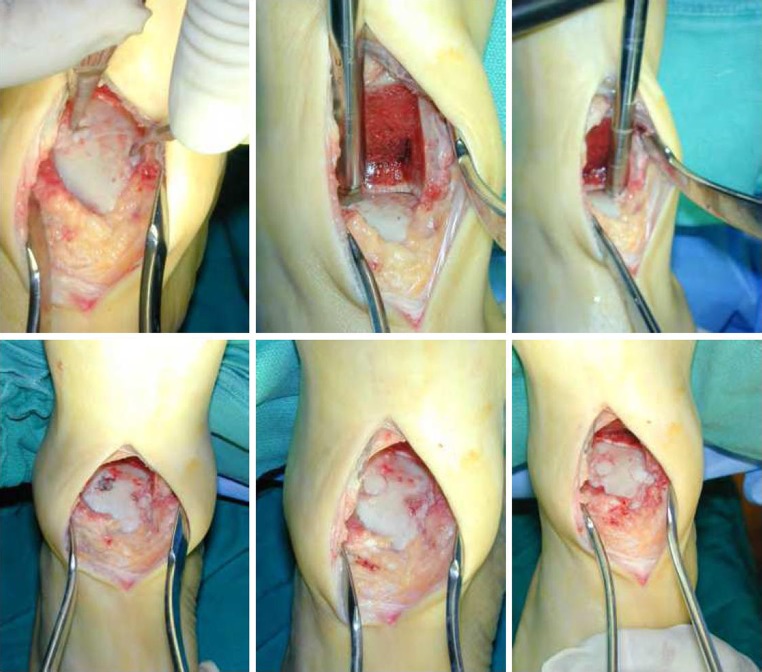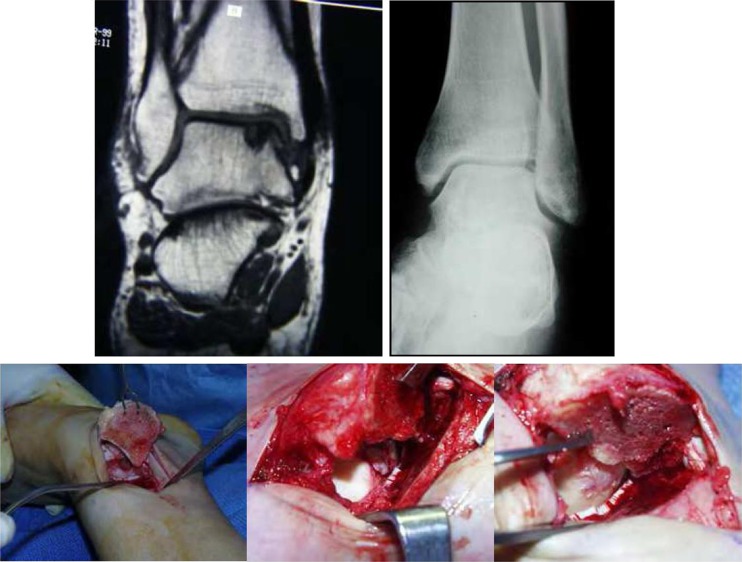Abstract
Osteochondral lesion of the talus (OLT) is a broad term used to describe an injury or abnormality of the talar articular cartilage and adjacent bone. A variety of terms have been used to refer to this clinical entity, including osteochondritis dissecans (OCD), osteochondral fracture and osteochondral defect. Whether OLT is a precursor to more generalised arthrosis of the ankle remains unclear, but the condition is often symptomatic enough to warrant treatment. In more than one third of cases, conservative treatment is unsuccessful, and surgery is indicated. There is a wide variety of treatment strategies for osteochondral defects of the ankle, with new techniques that have substantially increased over the last decade. The common treatment strategies of symptomatic osteochondral lesions include nonsurgical treatment, with rest, cast immobilisation and use of nonsteroidal anti-inflammatory drugs (NSAIDs). Surgical options are lesion excision, excision and curettage, excision combined with curettage and microfracturing, filling the defect with autogenous cancellous bone graft, antegrade (transmalleolar) drilling, retrograde drilling, fixation and techniques such as osteochondral transplantation [osteochondral autograft transfer system (OATS)] and autologous chondrocyte implantation (ACI). Furthermore, smaller lesions are symptomatic and when left untreated, OCDs can progress; current treatment strategies have not solved this problem. The target of these treatment strategies is to relieve symptoms and improve function. Publications on the efficacy of these treatment strategies vary. In most cases, several treatment options are viable, and the choice of treatment is based on defect type and size and preferences of the treating clinician.
Keywords: Osteochondral lesions, Osteochondritis dissecans, Talus, Foot and ankle, Cartilage damage, Subchondral bone
Introduction
Chondral and osteochondral injuries are relatively common in weightbearing joints of the lower extremity. Pathology can range from a simple contusion of the articular cartilage and subchondral bone to a fracture involving the cartilage alone or cartilage and underlying subchondral bone together. The mechanism of injury is from one of three types of trauma: compaction, shearing or avulsion. Because the injury is usually subtle and causes little to no dysfunction, the diagnosis of acute injuries is delayed. An osteochondral ankle defect is a lesion of the talar cartilage and subchondral bone caused primarily by single or multiple traumatic events, leading to partial or complete detachment of the fragment. Defects cause deep ankle pain associated with weightbearing. Impaired function, limited range of motion (ROM), stiffness, catching, locking and swelling may be present. The earliest report of osteochondritis dissecans (OCD) was published in 1888 by Konig, who characterised a loose-body formation associated with articular cartilage and subchondral bone fracture [1]. In 1922, Kappis described this process in the ankle joint [2]. On the basis of a review of all literature describing transchondral fractures of the talus, Berndt and Harty developed a classification system for radiographic staging of osteochondral lesions of the talus (OLTs) [3]. Their classification system has been the foundation for other systems, yet it remains the most widely used system today. Anatomical studies on cadaver limbs demonstrate the aetiological mechanism of transchondral fractures of the lateral border of the talar dome. As the foot is inverted on the leg, the lateral border is compressed against the face of the fibula (stage I), whereas the collateral ligament remains intact. Further inversion ruptures the lateral ligament and begins avulsion of the chip (stage II), which may be completely detached but remain in place (stage III) or be displaced by inversion (stage IV). Berndt and Harty experimentally proved the traumatic aetiology of the lesion; however, nontraumatic lesions also occur. Loomer et al [4] added a stage V to this system, considering the presence of a subchondral cyst. Ferkel and Sgaglione [5] developed a classification system based on computed tomography (CT), whereas Hepple et al. developed a classification system based on magnetic resonance imaging (MRI) [6].
There is a wide variety of treatment strategies for osteochondral defects of the ankle, and the number of new techniques substantially increased over the last decade. The common treatment strategies of symptomatic OLTs include nonsurgical treatment with rest, cast immobilisation and use of NSAIDs; surgical treatment includes surgical excision of the lesion, excision and curettage, excision combined with curettage and microfracturing, filling of the defect with autogenous cancellous bone graft, antegrade (transmalleolar) drilling, retrograde drilling, fixation and techniques such as osteochondral transplantation [osteochondral autograft transfer system (OATS)] and autologous chondrocyte implantation (ACI).
The target of these treatment strategies is to relieve symptoms and improve function. Publications on the efficacy of these treatment strategies vary. In most cases, several treatment options are viable, and the choice of treatment is based on defect type and size and on preferences of the treating clinician.
Principles of treatment strategies
Nonsurgical management
Conservative treatment usually consists of immobilisation and non weightbearing, with or without treatment with nonsteroidal anti-inflammatory drugs (NSAIDs), for approximately six weeks, followed by progressive weightbearing and physical therapy. This protocol is instituted for Berndt and Harty type I and II lesions and small grade III lesions. Large grade III and any grade IV lesions are generally considered operative candidates. Additionally, grades I and II lesions that fail nonsurgical management become operative candidates [7]. Berndt and Harty [3] reported poor outcomes for nonoperative treatment of OLTs in their original article: good in 16 %, fair in 9 % and poor in 75 %. A systematic review of treatment strategies for OLT by Verhage [8] et al. in 2003 demonstrated only a 45 % success rate for nonoperative treatment. The treatment aim is to unload the damaged cartilage, so oedema can resolve and necrosis is prevented. Tol et al. [9], in a review of the literature, noted a success rate of only 45 % with nonoperative treatment. Symptom duration prior to institution of nonoperative treatment was either unreported or ranged from subacute, to acute (less than six weeks), to chronic (more than six weeks). Patients were given the choice between operative and nonoperative treatment, and they chose nonoperative treatment. Conservative treatment consisted of weightbearing as tolerated, which was reported to be successful in the range of 20–54 %.
Surgical management
Retrograde drilling is usually reserved for large OCDs with intact overlying cartilage. This technique is used for stable primary OCDs when there is more or less intact cartilage with a large subchondral cyst or when the defect is hard to reach via the usual anterolateral and anteromedial portals, usually Berndt and Harty types I and II. Drilling is aimed at bringing blood supply to the lesion without disrupting the articular cartilage [10]. It is the treatment of choice when there is a large subchondral cyst with overlying healthy cartilage. For medial lesions, arthroscopic drilling can take place through the sinus tarsi. For lateral lesions, the cyst is approached anteromedially. The aim is to induce subchondral bone revascularisation and stimulate new bone formation. Kono et al. [11] and Taranow et al. [12] reported treatment success in the range of 81–100 %.
Transmalleolar antegrade drilling is considered in cases of OLTs that are difficult to approach because of their location on the talar dome. In this technique, a K wire is inserted about three centimetres proximal to the tip of the medial malleolus and directed across the medial malleolus into the lesion through the intact cartilage. Kono et al. [11] and Robinson et al. [13] described the results of this technique, which was reported to be successful in 63 % of cases.
Surgical treatment includes: excision, in which the partially detached fragment is excised and the defect itself is left untreated; excision and debridement, in which after excision of the loose body, the surrounding necrotic subchondral tissue is curetted using either an open or arthroscopic technique; excision, debridement and bone marrow stimulation (BMS), in which after excision and curettage, multiple openings into the subchondral bone are created by drilling or by microfracturing. This way, intraosseous blood vessels are disrupted and the release of growth factors leads to formation of a fibrin clot. The formation of local new blood vessels is stimulated, bone marrow cells are introduced into the osteochondral defect and fibrocartilaginous tissue is formed. Van Dijk et al. [14], in a review of the literature, noted a success rate of 54 % with the excision technique when performed for superficial cartilaginous lesions with mainly intact underlying subchondral bone. Respectively, excision and curettage had a reported success rate of 77 %, where most patients had a Berndt and Harty stage III or IV lesion, although stage II lesions occurred. Finally, excision, debridement and BMS had the best reported rate of success (85 %), where most patients often had a Berndt and Harty stage III or IV lesion, although stage I and II lesions occurred; lesion diameter usually did not exceed 1.5 cm. Kouvalchouk et al. [15] studied defect filling with an autogenous bone graft. In this technique, the remaining defect after excision and debridement of OLTs of the talar dome with partial necrosis is filled with autogenous cancellous bone with the aim of restoring mechanical properties of the talus. Indications for such treatment were large, often medial, lesions greater than 1.5 cm in diameter.
Larger lesions that fail to improve six months after arthroscopy should be considered for osteochondral grafting or autologous chondrocyte implantation. The concept of using restorative cartilage treatment with autograft and allograft is reported in the literature [16, 17]. The results of osteochondral autograft transplantation are reported at intermediate follow-up with good results. Two related procedures have been developed: mosaicplasty and OATS. Both are reconstructive bone grafting techniques that use one or more cylindrical osteochondral grafts from the less weightbearing periphery of the ipsilateral knee, which are then transplanted into the prepared defect site on the talus. The aim of this technique is to restore mechanical, structural and biochemical properties of the original hyaline articular cartilage. It is carried out either using an open approach or an arthroscopic procedure. Indications involve large, often medial, lesions, sometimes with a cyst underneath. Osteochondral grafting of defects yielded 90–94 % good to excellent results, with Scranton et al. [18] noting 90 % satisfaction in 50 patients at a 36-month follow-up and Hangody et al. [19] reporting 94 % good to excellent results in 36 patients at an average of 4.2 years.
Autologous chondrocyte implantation attempts to regenerate tissue with a high percentage of hyaline-like cartilage. The ACI technique involves placing cultured chondrocytes under a periosteal patch that covers the lesion. It is done for lesions larger than one square centimetre in the absence of generalised osteoarthritic changes. Harvesting is first accomplished from either the knee or ankle from the region on the perimeter of the talus lesion. A second procedure is performed after the cells have been cultured for six to eight weeks. An osteotomy of the medial malleolus can be performed for medial defects. The damaged articular surface is curetted to a stable border, and a periosteal patch is harvested from the tibia. The patch is sutured to the defect and sealed with fibrin glue. Finally, cultured chondrocytes are injected under the patch. Whittaker et al. [20] reported their results with ACI on ten patients with a four-year follow-up: 90 % of patients were pleased with the results at 24 months, with no change at 48 months.
In Europe and Australasia, matrix-based chondrocyte implantation (MACI) is available [21]. It differs from traditional ACI in that chondrocytes are not placed under the periosteal patch but embedded in a type I/III collagen membrane bilayer. As with ACI, the membrane is placed in the defect, but sutures are not required. The membrane bilayer is secured using fibrin sealant. MACI is technically easier than ACI and does not require an osteotomy.
Fixation is another treatment option in large, loose fragments that can be reattached to the underlying bone. Fixation to the talus may be obtained with headless screws, K wires, absorbable pins or fibrin glue. Kumai et al. [22] reported a success rate of 89 % in 24 patients, where OLTs stages II, III and IV were elevated and the defect was curetted and drilled. Following alignment of the bone fragment, it was secured to the underlying bone with at least two bone pegs from the distal tibia. These injuries are usually acute, and this technique typically fails in chronic lesions with sclerotic borders. However, the authors report that they prefer surgical treatment of talar OLTs using local osteochondral talar autograft for types III and IV OCD lesions and cases in which previous surgical treatment failed [23].
Materials and methods
From March 2005 to December 2008, we retrospectively evaluated a series of 58 patients: 37 men and one woman, with an age range of 19–53 (mean 38) years. Thirty-seven patients experienced sports-related injury, and symptom duration was a mean of 65 (range 6–98) months. Mean follow-up was 22.1 (range 14–32) months. Preoperative evaluations included clinical history, physical examination of the foot and American Orthopaedic Foot and Ankle Society (AOFAS) Ankle–Hindfoot Scale. Special radiological studies performed preoperatively were magnetic resonance imaging (MRI) (58 patients), computed tomography (CT) scan (58 patients), bone scan (three patients) and weightbearing radiographs for all. The majority of lesions n = 41 were on the medial aspect, 17 on the lateral talar dome and four medial and lateral. The graft was harvested from the medial or lateral talar articular facet on the same side as the lesion depending on lesion geometry. Graft sizes ranged from four- to eight-mm in diameter: four mm in six, six mm in 28 and eight mm in 24 patients. This technique is used for stages III and IV lesions according to Berndt and Hardy classification, and for stages I and II in symptomatic patients who have failed previous surgical treatment (Fig. 1) [24].
Fig. 1.
Berndt and Hardy classification
Associated findings after the preoperative control (Table 1) were 17 patients with pes planus, 11 with arthritis, eight with Achilles tendinopathy, three with tibialis posterior dysfunction, three with hallux rigidus, 13 with lateral ankle instability and two with previous pinning of the contralateral ankle. Additional procedures were a flexor hallucis longus tenosynovectomy and repair, excision of a lipoma, lateral ligament reconstruction (Broström modification), Achilles tendon lengthening, synovectomy and anterior ankle Impingement removal. Preoperative and postoperative results used the AOFAS Ankle–Hindfoot Scale [24]. Results were classified as excellent, good, fair or poor; patients were asked about their satisfaction following the procedure. Statistical analyses were performed using SPSS software.
Table 1.
Associated findings and history
| Diagnosis | Number of cases |
|---|---|
| Pes planus | 17 |
| Arthritis | 11 |
| Achilles tendon | 8 |
| Tibialis posterior dysfunction | 3 |
| Hallux rigidus | 3 |
| Lateral ankle instability | 13 |
| Previous pinning of contralateral ankle | 2 |
Surgical technique
All procedures were performed under tourniquet control with the patient in the supine position. An arthrotomy was performed through a seven centimetre anteromedial or anterolateral incision, as required. The lesion is approached by removing a bone block from the tibia, including the articular surface. To accomplish this, a wedge-shaped bone block ten-mm wide, 20-mm deep and 30-mm in height is made at the distal anterior tibia articular surface on the side of the OLT. Vertical parallel saw cuts are made with a high-speed micro-oscillating saw. Care is taken to avoid injuring the uninvolved talar articular surface. The saw was then used to connect the two vertical parallel cuts proximally in the metaphysis. A ten-mm-wide, thin osteotome is then driven from the superior portion of the transverse saw cut inferiorly to the articular surface of the tibial plafond ten- to 20-mm deep, depending on lesion location on the talar dome. The tibial fragment is removed and set aside to be replaced later (Fig. 2). The defect created in the tibia following removal of the bone fragment permits direct access to the lesion from above. The lesion is delivered into the field by plantar-flexing the ankle. It is prepared by first debriding the loosened cartilage fragments. The lesion is then drilled using the appropriately sized drill. Care is taken to ensure that the drill is perpendicular to the articular surface of the talus directly over the lesion. Drill sizes are matched to the diameter of the defect (four, six or eight mm) determined from the MRI. The osteochondral graft is harvested from the anterior aspect of the ipsilateral talar articular facet.
Fig. 2.
Trapezoid wedge shape for tibial osteotomy providing perpendicular access to the recipient site
A total of 15 grafts were harvested—two 4 mm, six 6 mm and seven 8 mm (Fig. 3)—performed through the same incision as the tibial osteotomy. The graft was harvested using the core-harvesting device (Fig. 4). The cutter was positioned over the talar facet near the anterior border, ensuring it was perpendicular to the articular surface. The inferior border of the talar facet flares outwards slightly, and the harvesting tube was oriented so that the flared margin could be identified and oriented towards the medial or lateral talar dome. This ensures that the graft shape will more closely approximate the saddle shape of the talar dome. The core-harvesting device was tapped with a mallet until the cutter reached the desired depth, rotated and removed with the graft held in the harvester tube. The outer cutter was removed, leaving the graft plug inside the tube, and a delivery guide was screwed onto the tube. A plunger was inserted into the proximal end of the tube. The assembled harvester tube, guide and plunger were positioned perpendicular to the talar dome over the prepared site in the talus, with the outer flair of the graft oriented towards the outer edge of the dome. The plunger was tapped gently, pressing the osteochondral graft plug into the hole (Fig. 5). The graft was inserted until it was flush and slightly proud to the overhanging surrounding cartilage. For true medial lesions, a Chevron-type medial malleolar osteotomy was performed at the end the osteotomy and fixed with two screws. The approach to lateral lesions was through an anterolateral incision by taking down the anterior tibiofibular ligament (ATFL) and the calcaneo-fibular ligament (CFL). Finally, a modified Broström reconstruction was performed. Postoperative treatment was immobilisation for four weeks, walker boot for four weeks and weightbearing at six weeks. ROM exercises were allowed once the surgical incision healed [23].
Fig. 3.
Donor medial talar facet-recipient site with the local graft inserted
Fig. 4.
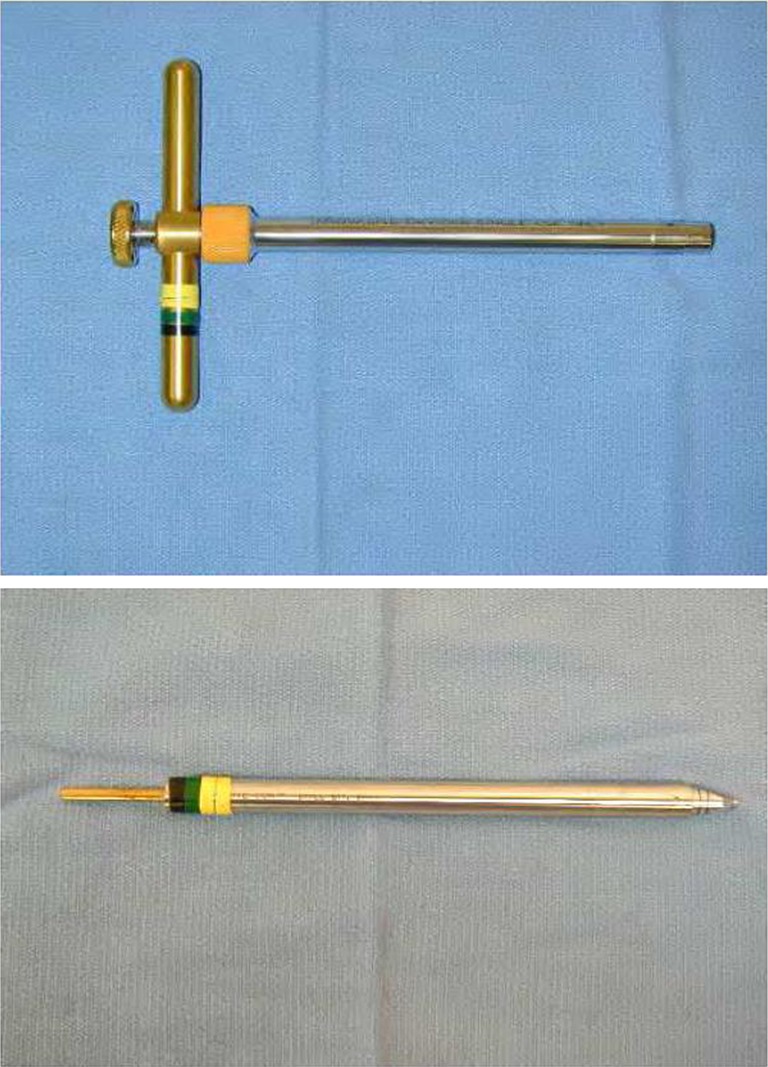
Instrumention
Fig. 5.
Perpendicular access to the recipient site: a case with two lesions
Results
Patients were evaluated both intraoperatively and postoperatively. Operative findings included degenerative joint disease in six cases, lipoma in two and lateral ankle ligament instability in two. Average preoperative AOFAS score using the Ankle–Hindfoot Scale was 65 and an average of 41 months’ follow-up; postoperative average was 89. Patients younger than 40 years had higher average AOFAS scores postoperatively than patients older than 40 (Table 2). The presence of degenerative arthritis yielded a lower AOFAS score. However, the difference between these small subgroups was not significant. No reciprocal “kissing lesions” were encountered on the tibial articular surface opposite the OLT. There was no deterioration in overall functional improvement in patients who underwent additional procedures. There were no perioperative complications. Long term, the most common complaint in patients over time was mild aching over the anterior aspect of the ankle, although this did not impair activities of daily living or sports. All patients stated they would undergo the procedure again.
Table 2.
Pre- and postoperative American Orthopaedic Foot and Ankle Society (AOFAS) Ankle–Hindfoot Scale scores
| Preoperative | Postoperative | |
|---|---|---|
| AOFAS | 65 | 89 |
| Under 40 years | 69 | 92 |
| No arthritis | 68 | 91 |
| Arthritis | 63 | 86 |
Evaluation of postoperative X-rays revealed no evidence of decreased joint space in the ankle. X-ray findings also revealed that the cyst visible preoperatively was no longer visible at the last follow-up visit. No increase in arthritis was noted. Clinical examination postoperatively revealed improved ROM, muscle strength, gait pattern and endurance. Patients returned to work eight months following surgery without restrictions.
Two patients underwent surgery subsequent to the index procedure: one had arthroscopy and removal of impinging osteophytes from the lateral malleolus six months following surgery, and one had arthroscopy with debridement of the anterior tibial margin at the site where the tibial bone block was removed 12 months following surgery (Fig. 6). In both cases, the cartilage of the graft appeared to have grown into the surrounding cartilage of the talar dome. The tibial articular cartilage on the tibial plafond also healed without articular-surface defects. It appeared that the talar osteochondral graft does not adversely affect the joint surface and easily incorporates into the surrounding surface cartilage [23].
Fig. 6.
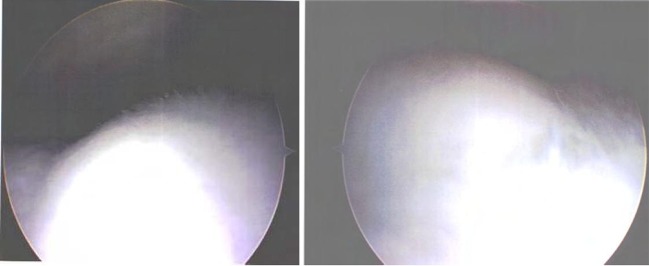
Second-look arthroscopy shows good incorporation of the local graft, with the same quality and thickness of the cartilage
Discussion
The talus is the third-most common location of OLTs after the knee and the elbow. Patients typically present after a traumatic injury to the ankle (85 %) and complain of prolonged pain, swelling, catching, stiffness and instability. Severe mechanical symptoms, such as catching and grinding, may indicate a severe OLT and possibly a loose body. A loose body can disrupt normal joint motion secondarily to the displaced fragment and can lead to arthrosis over time. Chronic ankle pain and stiffness without improvement from standard conservative measures should increase the suspicion of OLT.
OLTs more commonly affect men, the right ankle and the medial side. Lateral lesions are traumatic, whereas medial lesions may be atraumatic [3]. It has previously been recognised that medial and lateral lesions differ morphologically, with lateral lesions presenting as flat, discoid fragments and medial lesions presenting as deeper and more rounded [25]. MRI studies demonstrate that medial lesions tend to be deeper and more well defined, whereas lateral lesions are more superficial and less discrete in location. Lateral lesions are more liable to be displaced and so become symptomatic at an earlier stage. The morphological appearance of medial and lateral lesions can be explained by the different forces that are necessary to produce them. Lateral lesions are produced by a tangential shear force across the talar dome, whereas medial lesions are caused by a more perpendicular force, resulting in a deeper lesion that is unlikely to displace from its bed [26].
Treatment strategies for OCDs of the ankle have substantially increased over the last decade. The widely published treatment strategies for symptomatic OLTs include nonsurgical treatment and surgical excision of the lesion, excision and curettage, excision combined with curettage and microfracturing, placement of cancellous bone graft, antegrade (transmalleolar) drilling, retrograde drilling, fixation and techniques such as OATS and ACI. Retrograde drilling is used for stable lesions with an intact chondral surface (Berndt and Harty types I and II). Drilling aims at bringing blood supply to the lesion without disrupting the articular cartilage. Transmalleolar drilling is performed when a defect is hard to reach because of its location on the talar surface. A disadvantage with this technique is that healthy tibial cartilage is damaged. Primary repair works best for large OCDs with healthy-appearing surface cartilage that is attached to a bone fragment. Fixation to the talus may be obtained with headless screws, K wires or absorbable pins. This type of lesion is usually seen in acute injuries, and this technique typically fails in chronic lesions with sclerotic borders. Microfracture stimulates subchondral bleeding and development of a fibrin clot. Debridement of diseased cartilage and subchondral cysts prior to microfracture is of paramount importance. Awls or drills are used after sufficient debridement to perforate the base of the lesion (three- to four-mm apart) and bring mesenchymal stem cells, growth factors and healing proteins to the defect. This fibrin clot heals in the defect and eventually becomes fibrocartilage (type I cartilage), which fills the void but lacks the organised structure of hyaline cartilage (type II cartilage). Fibrocartilage shows inferior wear characteristics to hyaline cartilage, which has led investigators to develop articular cartilage transplantation. Restoring articular cartilage can be achieved by osteochondral autograft or allograft transplantation (OATS, mosaicplasty), ACI and MACI and fresh osteochondral allografts (FOCAT). The most important finding of a recent review of the literature by van Djik et al. [14] is that BMS was identified as the best treatment option. In the same review, results of nonoperative treatment were low compared with operative treatment. However, nonoperative treatment should always be the first treatment to be considered.
So nowadays, literature on treating OLTs involves arthroscopic excision, curettage and BMS, ACI and OATS. ACI is a relatively expensive technique, and OATS results in morbidity from knee complaints in a relevant number of patients. Therefore, arthroscopic excision, curettage and BMS is recommended [14] as the first-line treatment of choice for primary OLTs. It is relatively inexpensive, morbidity is low and it provides a quick recovery and a high success rate.
We introduce the use of local osteochondral graft this method has some serious advantages, for the type III and IV OCD lesions and cases that previous surgical treatment have failed.
Results of nonoperative treatment for stages III and IV OLTs are poor. Berndt and Harty, reviewing 200 cases from the literature and adding 24 of their own, found 73.9 % poor results with nonsurgical treatment. Of the 56 cases treated surgically, 78.6 % had good results [23]. O’Farrell and Costello [27] reported on 24 patients treated surgically and found the results were better with early diagnosis and treatment. This report was further substantiated by Pettine and Morrey [28] who retrospectively reviewed 68 patients at an average follow-up of 7.5 years and concluded that a delay in diagnosis and surgery resulted in a poor outcome. Whilst a high percentage of satisfactory results can be obtained with nonsurgical treatment for stage I and II lesions, most stage III and IV lesions require surgery. Canale and Belding [25] recommended that stage III and IV lateral lesions be treated surgically but that stage III medial lesions be treated nonsurgically initially. All lesions in our study were stage III or IV, and two thirds were related to sports injuries.
Surgical treatment for OLTs includes excision, excision and curettage with or without drilling, microfracture, cancellous bone grafting, internal fixation and osteochondral grafting. Review of the literature suggests a higher percentage of good and excellent results with excision and curettage with or without drilling the base of the lesion. Autologous osteochondral mosaicplasty was recently introduced and has evolved from treatment of osteochondral lesions of the knee. Hangody et al. [29] reported a high success rate in 11 patients treated with mosaicplasty autogenous osteochondral grafting for talar dome lesions using the knee as a donor site. However, donor-site morbidity can occur in up to 15−16 % of cases in an asymptomatic joint [8]. This increased morbidity can be avoided by harvesting the graft from a location on the talar dome, which carries minimal loads, and procedural risks are reduced. The graft is taken from the anterior part of the medial or lateral talar facet. As the graft size is relatively small, the integrity of anterior dome is maintained. There was no incidence of talus collapse either at the donor site or lesion site. The two patients on whom arthroscopy was performed revealed the graft was well incorporated on the surface of the joint. The chondral border of the graft revealed no line of degeneration or necrosis. Also, there was no additional change noted on the medial or lateral facet either at the lesion or donor site.
Our technique is to remove a portion of the anterior tibial plafond to access this lesion. Our method allows direct access to either side of the ankle, even if the lesion is located towards the posterior third of the dome. The defect is visualised from above after the bone block is removed. The bone block is then replaced and secured with an absorbable pin. There is no risk of malunion, as the block is replaced in the same position from which it was removed. In our experience, no fractures occurred in the tibia. The tibial graft held in place with gentle tapping without fixation, as it holds the bone block in place but does not carry load. Moreover, we use the same quality osteochondral graft: the knee cartilage is thicker than the talus cartilage and hence cannot incorporate precisely.
Some lesions are difficult to access even with this method. Such lesions are located in the posterior 20–30 % of the talar dome, particularly in the lateral posterior region of the talus. For these less common lesions, which are not included in this report, we expose the talus through a posterolateral incision and harvest the graft through a second anterior incision. Additionally for true medial lesions, we still perform an osteotomy of the medial malleolus (Fig. 7) because it is difficult to obtain perpendicular access to the recipient site through the wedge-shaped bone block at the distal anterior tibia articular surface on the side of the OLT.
Fig. 7.
Medial malleolus osteotomy for true medial lesions
For true lateral lesions, it is sometimes necessary to approach the lesion through an anterolateral incision. We take down the ATFL and the CFL in order to gain perpendicular access to the recipient site (Fig. 8 and then reconstruct the ligament with a standard modified Broström technique.
Fig. 8.
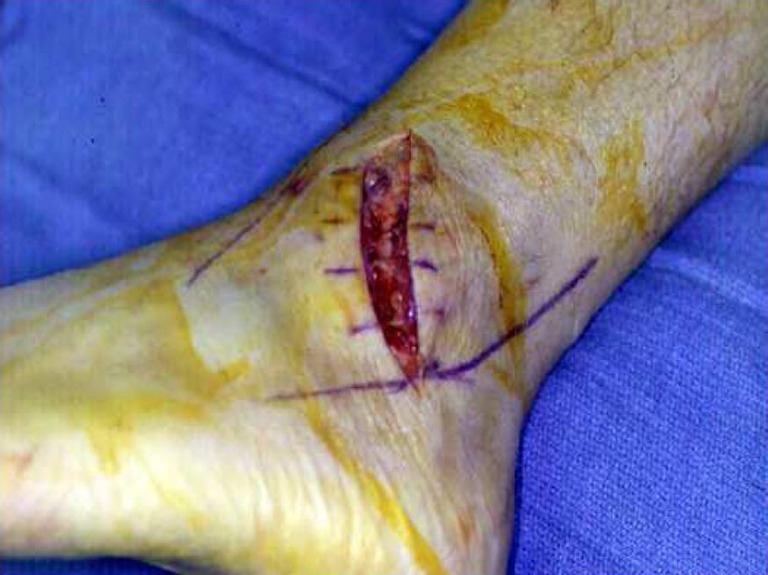
Lateral osteochondral lesion of the talus (OLT) approached through an anterolateral incision, with takedown of the anterior tibiofibular ligament (ATFL) and the calcaneofibular ligament (CFL). Reconstruction with modified Broström reconstruction
Overall improvement in AOFAS score in our study was 24 points at an average follow-up of 41 months. Improvement can be expected for as long as 18 months postoperatively [24]. Canale and Belding [25] found 15 of 31 cases (50 %) developed degenerative joint changes at an average of 11.2 years. The long-term success of preventing late joint degenerative changes has yet to be determined using our technique. However, according to our mid- and long-term results, we suggest that stage III and IV talar dome lesions can be treated successfully using local autogenous osteochondral grafts from the medial or lateral talar articular facet. This procedure can also be used in cases of failed previous procedures [drilling, microfracture (arthroscopic or not)]. This procedure is combined with removal of a tibial bone block and its subsequent replacement and does not yield complications experienced with other procedures [23].
Acknowledgments
Conflict of interest
None.
References
- 1.Konig F. Uber freie Korper in den gelenken. Dtsch Z Chir. 1988;27:90–109. doi: 10.1007/BF02792135. [DOI] [Google Scholar]
- 2.Kappis M. Weitere beitrage zur traumatisch-mechanischen entstehung der “spontanen” knorpela biosungen. Dtsch Z Chir. 1922;171:13–29. doi: 10.1007/BF02812921. [DOI] [Google Scholar]
- 3.Berndt AL, Harty M. Transchondral fractures (osteochondritis diseccans) of the talus. J Bone Joint Surg. 1959;41A:988–1020. [PubMed] [Google Scholar]
- 4.Loomer R, Fisher C, Lloyd-Smith R, Sisler J, Cooney T. Osteochondral lesions of the talus. Am J Sports Med. 1993;21(1):13–19. doi: 10.1177/036354659302100103. [DOI] [PubMed] [Google Scholar]
- 5.Ferkel RD, Sgaglione NA, DelPizzo W, et al. Arthroscopic treatment of osteochondral lesions of the talus: long-term results. Orthop Trans. 1990;14:172–173. [Google Scholar]
- 6.Hepple S, Winson IG, Glew D. Osteochondral lesions of the talus: a revised classification. Foot Ankle Int. 1999;20:789–793. doi: 10.1177/107110079902001206. [DOI] [PubMed] [Google Scholar]
- 7.Schachter AK, Chen AL, Reddy PD, Tejwani NC. Osteochondral lesions of the talus. JAAOS. 2005;13:152–158. doi: 10.5435/00124635-200505000-00002. [DOI] [PubMed] [Google Scholar]
- 8.Verhagen RA, Struijs PA, Bossuyt PM, van Dijk CN. Systematic review of treatment strategies for osteochondral defects of the talar dome. Foot Ankle Clin. 2003;8:233–242. doi: 10.1016/S1083-7515(02)00064-5. [DOI] [PubMed] [Google Scholar]
- 9.Tol JL, Struijs PA, Bossuyt PM, Verhagen RA, van Dijk CN. Treatment strategies in osteochondral defects of the talar dome: a systematic review. Foot Ankle Int. 2000;21:119–126. doi: 10.1177/107110070002100205. [DOI] [PubMed] [Google Scholar]
- 10.Anders S, Lechler P, Rackl W, Grifka J, Schaumburger J. Fluoroscopy-guided retrograde core drilling and cancellous bone grafting in osteochondral defects of the talus. Int Orthop. 2012;36(8):1635–1640. doi: 10.1007/s00264-012-1530-9. [DOI] [PMC free article] [PubMed] [Google Scholar]
- 11.Kono M, Takao M, Naito K. Retrograde drilling for osteochondral lesions of the talar dome. Am J Sports Med. 2006;34:1450–1456. doi: 10.1177/0363546506287300. [DOI] [PubMed] [Google Scholar]
- 12.Taranow WS, Bisignani GA, Towers JD, et al. Retrograde drilling of osteochondral lesions of the medial talar dome. Foot Ankle Int. 1999;20:474–480. doi: 10.1177/107110079902000802. [DOI] [PubMed] [Google Scholar]
- 13.Robinson DE, Winson IG, Harries WJ. Arthroscopic treatment of osteochondral lesions of the talus. J Bone Joint Surg Br. 2003;85:989–993. doi: 10.1302/0301-620X.85B7.13959. [DOI] [PubMed] [Google Scholar]
- 14.Zengerink M, Struijs PA, Tol JL, van Dijk CN. Treatment of osteochondral lesions of the talus: a systematic review. Knee Surg Sports Traumatol Arthrosc. 2010;18:238–246. doi: 10.1007/s00167-009-0942-6. [DOI] [PMC free article] [PubMed] [Google Scholar]
- 15.Kouvalchouk JF, Schneider-Maunoury G, Rodineau J, et al. Osteochondral lesions of the dome of the talus with partial necrosis. Surgical treatment by curettage and filling. Rev Chir Orthop Reparatrice Appar Mot. 1990;76:480–489. [PubMed] [Google Scholar]
- 16.Assenmacher JA, Kelikian AS, Gottlob C, Kodros S. Arthroscopically assisted autologous osteochondral transplantation for osteochondral lesions of the talar dome: an MRI and clinical follow-up study. Foot Ankle Int. 2001;22:544–551. doi: 10.1177/107110070102200703. [DOI] [PubMed] [Google Scholar]
- 17.Gautier E, Kolker D, Jakob RP. Treatment of cartilage defects of the talus by autologous osteochondral grafts. J Bone Joint Surg Br. 2002;84:237–244. doi: 10.1302/0301-620X.84B2.11735. [DOI] [PubMed] [Google Scholar]
- 18.Scranton PE, Jr, Frey CC, Feder K. Outcome of osteochondral autograft transplantationfor type-V cystic osteochondral lesions of the talus. J Bone Joint Surg Br. 2006;88:614–619. doi: 10.1302/0301-620X.88B5.17306. [DOI] [PubMed] [Google Scholar]
- 19.Hangody L, Fules P. Autologous osteochondral mosaicplasty for the treatment of full-thickness defects of weight-bearing joints: ten years of experimental and clinical experience. J Bone Joint Surg Am. 2003;2:25–32. doi: 10.2106/00004623-200300002-00004. [DOI] [PubMed] [Google Scholar]
- 20.Whittaker JP, Smith G, Makwana N, et al. Early results of autologous chondrocyte implantation in the talus. J Bone Joint Surg Br. 2005;87:179–183. doi: 10.1302/0301-620x.87b2.15376. [DOI] [PubMed] [Google Scholar]
- 21.Anders S, Goetz J, Schubert T, Grifka J, Schaumburger J. Treatment of deep articular talus lesions by matrix associated autologous chondrocyte implantation--results at five years. Int Orthop. 2012;36(11):2279–2285. doi: 10.1007/s00264-012-1635-1. [DOI] [PMC free article] [PubMed] [Google Scholar]
- 22.Kumai T, Takakura Y, Kitada C, et al. Fixation of osteochondrallesions of the talus using cortical bone pegs. J Bone Joint Surg Br. 2002;84:369–374. doi: 10.1302/0301-620X.84B3.12373. [DOI] [PubMed] [Google Scholar]
- 23.Badekas T (2012) Treatment of talar osteochondral lesions using local osteochondral talar autograft long term results, In tech an international perspective on topics in sports medicine and sports injury, chapter 25. Zaslav KR (Ed.), ISBN 978-953-51-0005-8
- 24.Badekas T, Evangelou E. Treatment of talar osteochondral lesions using local osteochondral talar autograft mid term results. Br J Sports Med. 2011;45:e1. [Google Scholar]
- 25.Canale ST, Belding RH. Osteochondral lesions of the talus. J Bone Joint Surg [Am] 1980;62-A:97–102. [PubMed] [Google Scholar]
- 26.Bruns J, Rosenbach B, Kahrs J. Etiopathogenetic aspects of medial osteochondrosis dissecans tali. Sportverletz Sportschaden. 1992;6:43–49. doi: 10.1055/s-2007-993526. [DOI] [PubMed] [Google Scholar]
- 27.O’Farrell TA, Costello BG. Osteochondritis dissecans of the talus: the late results of surgical treatment. J Bone Joint Surg Br. 1982;64-B:494–497. doi: 10.1302/0301-620X.64B4.7096430. [DOI] [PubMed] [Google Scholar]
- 28.Pettine KA, Morrey BF (1987) Osteochondral fractures of the talus. J Bone Joint Surg 69(B)1:89–92 [DOI] [PubMed]
- 29.Hangody L, Kish G, Krpáti Z, Szerb I, Eberhardt R. Treatment of osteochondritis disseuse of the mosaicplasty technique — Acans of the Ttalus. Uàa Int. 1997;18(10):628–634. doi: 10.1177/107110079701801005. [DOI] [PubMed] [Google Scholar]



